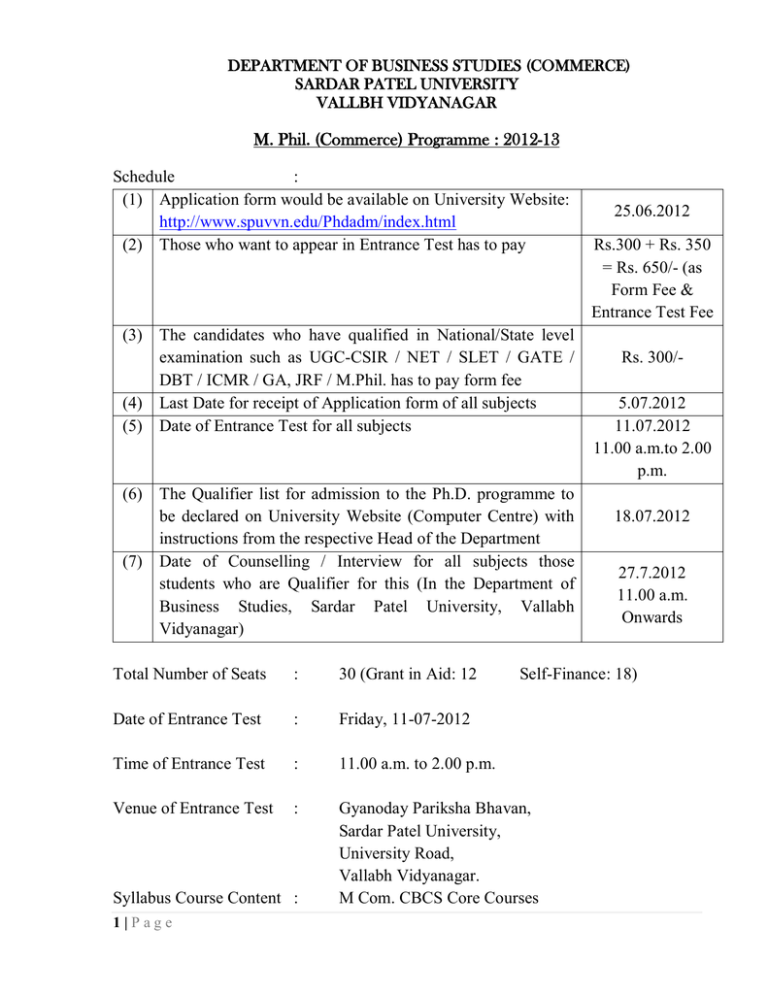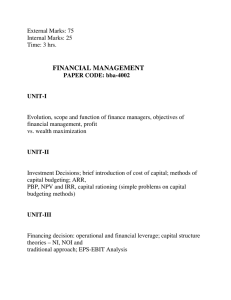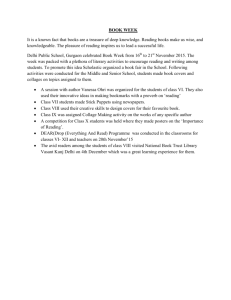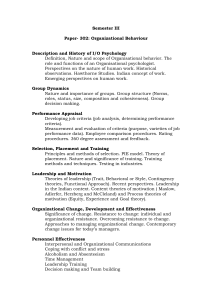M. Phil. (Commerce) Programme : 2012-13 Schedule :
advertisement

DEPARTMENT OF BUSINESS STUDIES (COMMERCE) SARDAR PATEL UNIVERSITY VALLBH VIDYANAGAR M. Phil. (Commerce) Programme : 2012-13 Schedule : (1) Application form would be available on University Website: http://www.spuvvn.edu/Phdadm/index.html (2) Those who want to appear in Entrance Test has to pay (3) (4) (5) (6) (7) The candidates who have qualified in National/State level examination such as UGC-CSIR / NET / SLET / GATE / DBT / ICMR / GA, JRF / M.Phil. has to pay form fee Last Date for receipt of Application form of all subjects Date of Entrance Test for all subjects The Qualifier list for admission to the Ph.D. programme to be declared on University Website (Computer Centre) with instructions from the respective Head of the Department Date of Counselling / Interview for all subjects those students who are Qualifier for this (In the Department of Business Studies, Sardar Patel University, Vallabh Vidyanagar) Total Number of Seats : 30 (Grant in Aid: 12 Date of Entrance Test : Friday, 11-07-2012 Time of Entrance Test : 11.00 a.m. to 2.00 p.m. Venue of Entrance Test : Gyanoday Pariksha Bhavan, Sardar Patel University, University Road, Vallabh Vidyanagar. M Com. CBCS Core Courses Syllabus Course Content : 1|Page 25.06.2012 Rs.300 + Rs. 350 = Rs. 650/- (as Form Fee & Entrance Test Fee Rs. 300/5.07.2012 11.07.2012 11.00 a.m.to 2.00 p.m. 18.07.2012 27.7.2012 11.00 a.m. Onwards Self-Finance: 18) Semester – I ACCOUNTING FOR MANAGERIAL DECISIONS PB01CCOM03 BUSINESS ENVIRONMENT PB01CCOM02 BUSINESS MANAGEMENT PB01CCOM01 Semester – II MANAGEMENT ACCOUNTING PB02CCOM03 ENTREPRENEURSHIP DEVELOPMENT PB02CCOM01 STRATEGIC MANAGEMENT PB02CCOM02 Semester – III RESEARCH METHODOLOGY PB03CCOM01 HUMAN RESOURCE MANAGEMENT PB03CCOM02 FINANCIAL MANAGEMENT PB03CCOM03 Semester – IV PORTFOLIO MANAGEMENT PB04CCOM03 INTERNATIONAL BUSINESS ENVIRONMENT PB04CCOM01 MARKETING MANAGEMENT PB04CCOM02 Syllabus of the Core Courses: Semester – I COURSE TITLE: ACCOUNTING FOR MANAGERIAL DECISIONS CODE NO. : PB01CCOM03 UNIT 1 : UNIT 2 : 2|Page Basic Aspects of Cost Accounting - Evolution of Cost Accounting - Meaning: Cost, Costing, Cost Accounting, Cost Accountancy - Objectives - Cost Accounting and Financial Accounting - Advantages - Disadvantages - Installation of Cost Accounting - Cost Unit, Cost Centre, Profit Centre - Classification of Costs, - Methods and Techniques of Costing - Specific order costing – Theory & Example - Special Cost for Managerial Decisions (in brief): Relevant Cost, Sunk Cost, Differential Cost, Marginal Cost, Out of Pocket Cost, Imputed Cost, Future Costs, Conversion Costs, Production Costs. Marginal Costing and Absorption Costing (Theory & Example) - Meaning and Definition - Features - Advantages and Disadvantages - Comparison of Marginal and Absorption Costing - Comparison of Marginal and Differential Costing - Managerial uses of Marginal Costing Examples : Profit Planning, Foreign Offer, Sales/Product Mix, Key Factor UNIT 3 : Cost Audit - Meaning - Types, Advantages, Disadvantages, Techniques - Cost Audit Programme - Cost Auditors: Functions, Appointment: Qualification, Disqualification, Rights, Duties, Responsibilities - Cost Audit V/s Financial Audit - Cost Audit Report and Financial Audit Report - Cost Audit and Cost Investigation - Sachar Committee’s Report - Cost Audit in India Standard Costing - Uses of Material Variances, Labour variance, Sales and Profit Variances - Zero-Base Budgeting - Comparison of Standard Costing and Budgetary Control System UNIT 4 : Activity Based Costing (ABC) (Theory & Example) - Introduction - Performing Steps - Cost Drivers o Types of Cost Drivers - Classification of Activities in Manufacturing Organisations - Advantages o ABC in Service Organizations o Conventional Costing System and ABC System - Disadvantages - Target Costing - Life Cycle Costing - Kaizen Costing References Books 1. Arora M. N. (2004), A Textbook of Cost Accountancy, Vikas Publishing House Pvt. Ltd., New Delhi. 2. Gupta Kamal (2007), Contemporary Auditing, Tata McGraw Hill Publishing Co. Ltd., New Delhi. 3. Jain S. P. and Narang K. L. (2008), Cost Accounting, Kalyani Publishers, New Delhi. 4. Shah Paresh (2009), Management Accounting, Oxford University Press, New Delhi. Journals 1. Indian Journal of Accounting 5. The Management Accountant COURSE TITLE : BUSINESS ENVIRONMENT UNIT 1 : 3|Page Business and Business Environment Nature of Business Scope of Business Classification of Business Characteristics of Business Goals of Business Objectives Business Environment - Meaning of Business Environment - Types of Environment - Internal Environment CODE NO. : PB01CCOM02 - Micro Environment & Macro Environment Economic Environment - Nature of the Economy - Structure of the Economy - Economic Policies & Economic Conditions Political and Government Environment: - Classifications of functions of state, - Economic Roles of Government in India, - Government and Legal Environment Natural and Technological Environment: - Natural Environment - Technological Environment, Innovation - Technology and Competitive Advantages - Sources of Technological Dynamics - Impact of Technology on Globalization, ICT and Marketing - Transfer of Technology Demographic Environment: - Importance of Demographic Environment - Falling Birth Rate and Changing Age Structure - Migration and Ethnic Aspects UNIT 2:Review of Selected Macro Policies of Indian Business and Government - Brief Review of Economic Planning in India (With emphasis on latest Two Five year plans) - The Industrial Policy of 1991 of Government of India. - The current Monetary Policy of RBI, the Fiscal and Exim Policy of the Government. - An outline of the Technology Policy adopted by GOI UNIT 3: Macro Strategies and Regulatory Acts of Indian Business and Government Liberalization: - Concept - Issues and it’s implications on Indian Economy. Privatization: - Meaning of Privatization - History of Privatization - Nature and Objectives of Privatization - Various forms of privatizing the Public Sectors Enterprises - Merits and Demerits of Privatization, Disinvestment in India Globalization: - Meaning - Globalization of Business - Features of Current Globalization - Stages of Globalization, essential Conditions for Globalization - The Foreign Market Entry Strategies or Strategies of Globalization - Pros and Cons of Globalization, Policy Options - The Globalization of Indian Business From Foreign Exchange Regulation Act (FERA) to the Foreign Exchange Management Act (FEMA), 1999: - The Regulation of Foreign Exchange Transactions - Foreign Exchange Management Act, FERA and FEMA- A Comparison UNIT 4:Business and Society Social Responsibility of Business (SRB): - Meaning of SRB - Factors affecting Social Orientations - Barriers to SRB SRB towards different sections – - SRB towards Shareholders 4|Page - SRB towards Employees - SRB towards Consumers - SRB towards the Society or the Community Consumer Rights, Consumerism and Business: - Consumer Rights - Consumerism - UN Guidelines for Consumer Protection - Consumer Protection and Consumerism in India - Consumer Protection Act, 1986 References: 1. Francis Cherunilam, Business Environment (Text and Cases), 18th Revised Edition, 2008, Himalaya Publishing House Private Limited. 2. K.Ashwathappa, Essentials of Business Environment, 10th Edition, 2008, Himalaya Publishing House Private Limited. COURSE TITLE : BUSINESS MANAGEMENT UNIT 1 : UNIT 2 : UNIT 3 : UNIT 4 : CODE NO. : PB01CCOM01 Nature of Management & Organizational - Concept of management - Importance of management - Nature of Organizational change - Factors in Organizational change - Planned change (process) - Human response to change - Role of change agents Social and Ethical Issues in Management - Social responsibility of manager - Arguments for and against social responsibility - Approaches for measuring social performance - Operation of social responsibility in India - Ethical issues in management - Concept - Need for ethics in management Conflict and Coordination - Concept - Functional and dysfunctional aspect of conflict - Individual level and Interpersonal conflict - Conflict management - Need for coordination - Types of coordination - Techniques of effective coordination Total Quality Management - Introduction - Definition of Quality - Meaning of TQM - Characteristics of TQM - Potential benefits of TQM - TQM and Traditional Management References: Books 1. Prasad L.M., Principles and Practice of Management, Sultan Chand & Company 2. Burton Gene, Thakur Manab, Management Today (Principles and practice) 3. Mohanty R.P. & Lakhe R.R. Hand book of Total Quality Management Journals 1. Business Perspective, Birla Institute of Management Science and Technology 2. GITAM – Jorunal of Management, Gitam Institute of Management, Visakhapatnam. SEMESTER – II COURSE TITLE : MANAGEMENT ACCOUNTING 5|Page CODE NO. : PB02CCOM03 UNIT 1 : Management Accounting Evolution Meaning and Definitions Scope Functions Tools & Techniques Principles Financial Accounting, Cost Accounting and Management – Accounting- comparison The Management Accountant Limitations Decision making-meaning and process UNIT 2 : Human Resource Accounting ( Theory and Example) Concept Objectives Importance Valuation of HRA - Examples Disclosure and recording in financial statement Human Resource Accounting in India Accounting for price level changes ( Theory and Example) Introduction Inflation Accounting Limitations of historical financial statement CCA & CPP – Preparation of price level adjusted financial statement – examples Advantages and Disadvantages Environmental Accounting Meaning & Definition Approaches Merits & Demerits Problems of Environmental Accounting Environmental Accounting Practices in India UNIT 3 : UNIT 4 : References Books: 1. Arora, M. N., Management Accounting - Theory, Problems and Solutions, Himalaya Publishing House, New Delhi. 2. Jawaharlal, Accounting for Managers, Himalaya Publishing House, New Delhi. 3. Kulshrestha, N. K., Management Accounting – Concepts & Cases, Tata McGraw Hill Publishing House Company Ltd., New Delhi. 4. Maheshwari, S. N., Management Accounting & Financial Control, Sultan Chand & Sons, New Delhi. 5. Sonara, C.K., Corporate Environmental Accounting & Reporting, Sardar Patel University Press, Vallabh Vidhyanagar, 2010. Journals: 6. Indian Journal of Accounting. 7. The Management Accountant. COURSE TITLE: ENTREPRENEURSHIP DEVELOPMENT CODE NO. : PB02CCOM01 UNIT 1 : UNIT 2 : 6|Page Concept of Entrepreneurship - Concept of entrepreneur, intrapreneur and entrepreneurship - Common characteristics of successful entrepreneurs - Types of entrepreneurs - Economic and industrial contribution of entrepreneurship in national economy - Rural Entrepreneurship and TRYSEM - Backward Area Development Women Entrepreneurship - Concept and Growth of Women Entrepreneurship - Rural Women Entrepreneurship - National-level associations working for Women Entrepreneurship Development - Problems being faced by women entrepreneurs and remedies UNIT 3 : UNIT 4 : - Profile of woman entrepreneur and her business - Success stories of Women Entrepreneurs Entrepreneurial Development - Concepts of Entrepreneurial Training and Development - Meaning of EDP, Misconceptions about EDP - Importance, objectives, principles and methods of EDP - Model of EDP - Target Groups for EDP - EDP Organisations Small Business - Concept and Classification - Small Business as a driving force for national economy - Procedure to start a small business unit - Problems of small entrepreneurs Reference Books: 1. Desai Vasant, “Dynamics of Entrepreneurial Development and Management”, Himalaya Publishing House, Mumbai. 2. Gupta C. B. and Srinivasan N. P., “Entrepreneurial Development”, Sultan Chand and Sons, New Delhi. 3. Kulshreshta Kalyani, “Successful Entrepreneurship”, Kanishka Publishers, Distributors, New Delhi. 4. Wadhwa, Davar & Rao, “Entrepreneur and Enterprise Management”, Kanishka Publishers, Distributors, New Delhi. COURSE TITLE : STRATEGIC MANAGEMENT CODE NO. : PB02CCOM02 UNIT 1 : UNIT 2 : UNIT 3 : UNIT 4 : References: 7|Page Nature and Scope of Strategic Management: - Nature and element of Strategy - Characteristics of effective Strategy - Hierarchical levels of Strategy - Meaning and Definition of Strategic Management - Strategic Management Process - Key attributes and benefits of Strategic Management Strategic Intent - Nature and Attributes of Strategic Intent - Purpose and Process of Strategic Intent - Vision: Meaning, Examples of Vision, How is Vision created, Characteristics and benefits of effective vision - Mission: Meaning, Objectives, Components, characteristics of effective mission - Objectives: Characteristics, kinds of objectives, Approaches to determine objectives Analysis of External and Internal Environment - Nature of environment, objective and process of environment appraisal - Competitive environment, Porter’s five force model - Process of internal environment appraisal - Measuring strength and weakness, SWOT Analysis - Value chain analysis Corporate & Business Level Strategy and Strategy Implementation - Nature of Corporate Strategy - Growth strategy - Diversification strategy - Nature of stability and Retrenchment strategy - Corporate restructuring - Nature of Business level strategy - Nature of strategy implementation - Interrelationship between formulation and implementation - Issues in strategy implementation 1. Management Policy and Strategic Management (Concepts, skills and practices) By, R.M.Srivastava, Himalaya publication 2. Strategic Management By, G.Sudarsana reddy, Himalaya publication. SEMESTER -III COURSE TITLE : RESEARCH METHODOLOGY CODE NO. : PB03CCOM01 UNIT 1 : Introduction - Meaning of research - Objectives of research - Motivation in research - Types of research - Significance of research - Research methods v/s Research methodology - Stages of the research process UNIT 2 : Problem Identification, Research Proposal & Hypothesis - Defining the research problem - Selecting the problem - Techniques involved in defining a problem - Necessity of defining the problem - Research proposal - Hypothesis – meaning and types UNIT 3 : Collection of data (A) Primary data : Personal interview Telephone interview Mail & Self administered questionnaire Schedule v/s Questionnaire (B) Secondary data: Advantages of secondary data Sources of secondary data Classification & Limitations UNIT 4 : Research Report - Significance of research report - Types of research report - Steps of research report - Precautions for research report - Synopsis of research report - Limitations of research report References: 1. Kothari, C. R. (2009), Research Methodology, Vikas Publishing House, New Delhi. 2. Zikmund, William G. (2009), Business Research Methods, Cengage Learning India Private Ltd., New Delhi. 3. Sachdeva, J.S. (2008), Business Research Methodology, Himalaya Publishing House, New Delhi. COURSE TITLE : HUMAN RESOURCE MANAGEMENT CODE NO. : PB03CCOM02 UNIT 1 : Introduction - Definition and Meaning - Difference between Personnel Management and HRM - Objectives - Scope - Functions UNIT 2 : HRR (Human Resource Recruitment) - Concept of HRR - Factors affecting Recruitment - Sources of Recruitment 8|Page - Process of HRR - Recruitment Practices in India UNIT 3 : Managing Human Resources for Change - Concept of OC, Internal and External Factors in OC - Human Response to Change - Resistance to Change - Management of Change or Overcoming Change - Process of Planned Change UNIT 4 : Case Analysis in HRM - Concept and Objectives of Case Analysis - Difference between Lecture Method and Case Method - Role of Teacher and Students during Case Analysis - How to analyse a case? OR Process of Case Analysis - Limitations of Case Analysis Selected References: 1. K. Aswathappa, “Human Resource Management – Text & Cases”, Tata McGraw Hill Companies, New Delhi, 7th Reprint 2008. 2. L. M. Prasad, “Organisational Behaviour”, Sultan Chand and Sons, New Delhi, 4 th Edition – Reprint 2008. 3. P. Subba Rao, “Personnel and Human Resource Management – Text and Cases”, Himalaya Publishing House, Mumbai, 4th Edition 2009. 4. S. S. Khanka, “Human Resource Management- Text and Cases”, Sultan Chand and Sons, New Delhi, First Edition – Reprint 2008. 5. S. V. Ganakar and C. B. Mamoria, “Personnel Management: Text and Cases,” Himalaya Publishing House, Mumbai, 28th Edition 2008. COURSE TITLE : FINANCIAL MANAGEMENT UNIT 1 : UNIT 2 : UNIT 3 : 9|Page CODE NO. : PB03CCOM03 Financial Strategy and Reporting - Financial strategy formulation - Sales Plan - Production Plan - Measurement of Income and Capital - Impairment of Fixed Assets, Brand and Goodwill - Analysis of Financial Statement - Vision Focus - Corporate Sustainability, Initiatives and Achievements - Directors Report - Corporate Governance Report - EVA + (Positive) Report - Highest Performance Achievement Area Corporate Restructuring - Meaning and Objectives of Corporate Restructuring - Forms of Corporate Restructuring - Mergers, Amalgamations and Acquisitions - Financial Considerations in Mergers, Amalgamation and Acquisitions - Legal and Procedural Aspects of Amalgamations or Acquisitions - Diversification versus Disinvestment Strategies - Tax Implications International Financial Management - World Monetary System UNIT 4 : - Foreign Exchange Markets and Rates - International Parity Relationships - International Capital Budgeting- Examples - Financing Foreign Operations - Raising Foreign Currency finance - Financing Exports - Foreign Exchange Exposure - Management of Foreign Exchange Exposure Sources of International Long-Term Finance and International Trade Finance - Risk associated with Project Financing - Issue of ADR/GDRs - FCCBs and FCEBs - ECBs and FDIs - Foreign Capital Markets and Instruments - QIBs and FIIs - Multilateral Agencies - Other International Finance Sources - Forms of Export Finance - Forfeiting - Documentary Control - Export Credit and Insurance - Special Economic Zones References: 1. Maheshwari. S. N., Accounting & Financial Control. 2. Singh Narendra, Advanced Financial Management, Himalaya Publishing House. 3. Varn Horne, Financial Management and Policy. 4. Chandra Prasan, Financial Management. 5. Kishore R. M., Financial Management, Taxmann’s Publications. 6. Gordon E. and Natarajan K., Financial Markets and Services, Himalaya Publishing House. SEMESTER - IV COURSE TITLE : PORTFOLIO MANAGEMENT UNIT 1 : The Financial System of India - Functions of the Financial Market - Financial Concepts UNIT 2 : 10 | P a g e CODE NO. : PB04CCOM03 Financial Assets Financial Intermediaries Financial Markets Financial Rates of Return Financial Instruments - Weakness of Indian Financial System The Investment Environment and Stock Markets - Organization of Stock Exchanges in India - Stock Exchange: Concept, Functions, Regulation and Reforms - New Issue Market and Secondary Market - Stock Exchanges in India - Various Securities and their characteristics - Stock Market Terminology - Role and Powers of SEBI - Deficiencies and Defects of Stock Markets - Method of Trading in Stock Exchange - On-line Trading UNIT 3 : Concept of Security Analysis - Meaning of Security Analysis - Factors affecting Security Prices - Valuation of Debentures - Valuation of Preference Shares - Valuation of Equity Shares - Yield to Maturity - Technical Analysis - Fundamental Analysis - Efficient Market Hypothesis UNIT 4 : Portfolio Management - Introduction - Traditional Versus Modern Portfolio Analysis - Markowitz Theory - Return and Risk of Portfolio - Measurement of Portfolio Risk - Efficient Portfolio Risk - Diversification of Risk - Capital Asset Pricing Model - Examples Based on CAPM - Arbitrage Pricing Theory Reference Books: 1. Kishore .R.M, Financial Management. Taxmann’s Publications. 2. Gordon E. and Natarajan. K., Financial Markets and Services, Himalaya Publishing House. 3. Bhalla. V.K., Investment Management, S.Chand Publications. 4. Singh Preeti, Portfolio Management, Himalaya Publishing House. 5. Madhumati, Rangarajan, Investment Analysis and Portfolio Management. COURSE TITLE: INTERNATIONAL BUSINESS ENVIRONMENT CODE NO. : PB04CCOM01 UNIT 1 : Introduction of International Business Environment - What is International Business and it’s evolution? - Meaning of International Business Environment - Features of International Business Environment - Importance of International Business Environment - International Business Environment: A System Approach - Factors affecting International Business Environment - International Economic Environment - International Political Environment - International technological environment - International Socio-cultural environment - International Legal Environment UNIT 2 : International Investment - Types of foreign Investment - Significance of foreign Investment - Limitation and ganger of foreign capital - Factor affecting international investment 11 | P a g e UNIT 3 : UNIT 4 : - Growth of FDI - Directional Trend - Sectoral Trend - Cross boarder M & As - Foreign Investment in India - Foreign Investment by Indian Companies Multinational Corporation - Introduction of MNCs - Meaning and Definition of MNCs - Organizational Model - Dominance of MNCs - International Trade and MNCs - Merits of MNCs - Demerits of MNCs - Perspective of MNCs - Code of Conduct - Multinational in India GATT/WTO and Global Liberalization - GATT - The Uruguay Round - Salient Features of UR Agreement - GATS - TRIMS - TRIPS - Evaluation of the Uruguay round - Evaluation of TWO, Doha Declaration - WRO and Developing countries - WTO and India Development and Regulation of Foreign Trade - Qualitative and Quantitative restriction - Regulation of Foreign trade - Export promotion - Free trade area - A customs union and Common market - European Union (EU) - North American Free Trade Agreement (NAFTA) - Inconterms - Ex-works, FOB, C.I.F, DDP etc References: 1. Dr. S. Porkodi & Dr. Ansarul Haque: International Business Environment, Global Vision Publishing House, New Delhi, 1st Edition, 2010. 2. Francis Cherunilam, Business Environment, Himalaya Publishing House, Eighteenth revised edition-2008. 3. K. Ashwathappa, Essentials of Business Environment, 10 th Edition, 2008, Himalaya Publishing House Private Limited. 4. Francis Cherunilam, International Trade and Export Management, 15th Revised edition, Himalaya Publishing House Private Limited. COURSE TITLE : MARKETING MANAGEMENT UNIT 1 : Understanding Marketing Management - What is marketing? 12 | P a g e CODE NO. : PB04CCOM02 - Core concepts of Marketing - The basic tasks of Marketing Manager - Business Strategic Planning UNIT 2 : Winning Markets through Market-Oriented Strategic Planning - Corporate and Division Strategic Planning - The Marketing Process - Product Planning - The Nature and Contents of a Marketing Plan UNIT 3 : Designing Marketing Strategies for Market Leaders, Challengers, Followers and Nichers - Market-Leader Strategies - Market-Challenger Strategies - Market-Follower Strategies - Market-Nicher Strategies UNIT 4 : Organising, Implementing, Evaluating and Controlling Marketing Activities - Marketing Organisation (The Evolution of the Marketing Department) - Ways of Organising the Marketing Department - Marketing Implementation - Controlling Marketing Activity Annual Plan Control Profitability Control Efficiency Control Strategic Control References Books 1. Kotler Philip, Marketing Management: Analysis, Planning, Implementation and Control, Prentice-Hall of India Private Ltd., New Delhi. 2. Sherlekar S. A., Marketing Management, Himalaya Publishing House, Bombay – 400004. Journals 1. Indian Journal of Marketing Management, New Delhi. 2. 4 Ps, Plan Media Publication. 13 | P a g e Format of the Question Paper: Section – I : 10 Marks objective questions of general knowledge of the subject Section – II : 40 Marks objective / multiple choice questions Section – III : 25 Marks short answer questions (Five Short –answer questions on the subject) Section – IV : 25 Marks long answer questions (Long-answer questions with or without sub-questions on the subject) The test shall be of 100 marks and 3 hours duration. This test shall carry a weight age of 60% in the final merit list, and the remaining 40% of weight age shall be given to the marks/grades/CGPA obtained by an applicant in external theory examination at the Master’s level. Considering both the weight ages a final merit list will be prepared and notify by the Department/ University. The minimum passing marks is 40%. The question paper-cum-answer book would contain questions together with appropriate space for answers to be written there in only and to be submitted. Instructions: 1. The candidate should take the seat at least 15 minutes prior to the scheduled starting time. 2. The candidates appearing for the entrance test are required to bring HB Pencils, Pencil Sharpener, Eraser, Black and Blue Pens. 3. All answers should be marked on the answer sheet. The method of indicating the answer is by using Pen; Pencil will be indicated to the Question Paper. 4. Candidates are not allowed to bring calculators mobile phones or any other calculation or communication device. There will be no provision for safe keeping of valuables, mobile phones, etc. 5. You have to write and/or darken all the information required in the answer sheet such as seat number, test form number, etc. Specialisation (Please Tick): 1. Accountancy 2. Human Resource Management 3. Marketing Management 4. Finance 5. Any other (Specify) _______________________ 14 | P a g e MODEL QUESTION PAPER-CUM-ANSWER BOOK Total Marks of the Entrance Test: 100 (60% written test + 40% weight age of external theory of P.G. Degree) Admission in M. Phil. Programme on the basis of Merit only (i.e. 60% + 40%) SECTION I (10 Marks of Ten objective questions of general knowledge of the subject) (1) Who is considered as Father of Management? (a) Henery Fayol (b) Peter Drucker (c) C. K. Prahlad (d) Maslow SECTION II (40 Marks of forty objective / multiple choice questions) (1) Fayol propounded _________ principles of organization? (a) 12 (b) 13 (c) 14 (d) 16 SECTION III (25 Marks short answer questions) Attempt Any FIVE from the following EIGHT short answer questions (in short i.e.5 to7 lines) (1) Define “control” as one of the functions of Management. ________________________________________________________________________ ________________________________________________________________________ ________________________________________________________________________ ________________________________________________________________________ SECTION IV (25 Marks long answer questions) Attempt Any ONE from the following FIVE long answer questions (500 words) (1) Explain Fiscal Policy with its objectives. 15 | P a g e


